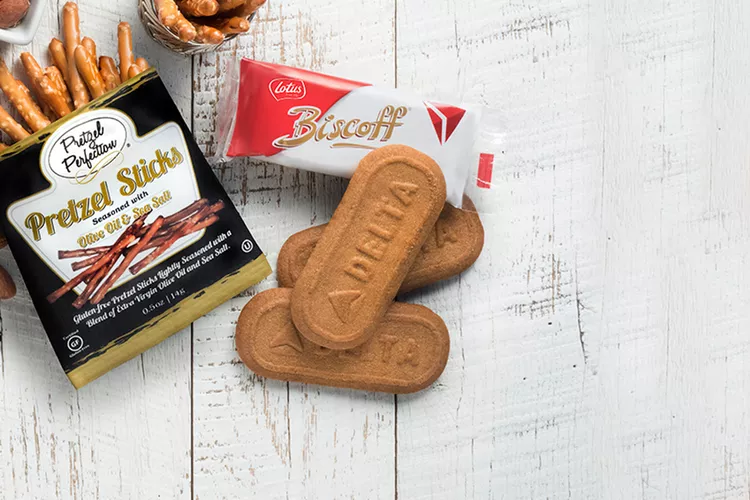Summary
- Introduction to Biscoff cookies and their connection to air travel.
- The role of Delta Airlines in popularizing Biscoff.
- The broader impact of Biscoff on passenger experience and airline loyalty.
The Biscoff is a small rectangular cookie with a satisfying, caramelized crunch. However, it’s more than a mere confection; it actually serves as a reliable predictor of how often someone parks themselves on a plane. If you rarely find yourself in the sky, you might be unfamiliar with this beloved Belgian snack food. Conversely, if you’re a frequent flier, it’s more ubiquitous than an Oreo. So, here’s some food for thought: How did this one sweet biscuit successfully associate itself with air travel?
More than any other domestic carrier, Delta Airlines deserves the credit here. The commercial airliner began serving the Lotus brand of Biscoff in the mid-1980s, making it the first airline to do so. In its native Belgium, it’s an example of a traditional style of cookie known locally as Speculoos — made with flour, candy syrup, and cinnamon. Consequently, it stood out as a novel snack to most American audiences at the time.
Back then, amenities were typically more robust for economy passengers, and yet this simple pleasure found an immediate audience. The appeal was understandable: they are bite-sized and assertive in both texture and sweetness, qualities that are especially appreciated at high altitudes, where our sense of smell and taste can diminish. You need something punchy to stand out.
They also pair wonderfully with coffee. In fact, the name “Biscoff” itself is a portmanteau of biscuit and coffee. Despite longstanding caveats regarding airline coffee, it remains one of the most popular beverages consumed on flights. Therefore, offering something specifically designed to complement a cup of joe provided an inherent selling point. It wasn’t long before Delta purpose-branded the cookies to make them distinctly their own.
“We began serving Biscoff cookies stamped with the Delta logo in the late 1990s,” shares Mike Henny, managing director of onboard services for Delta Airlines. “[They’ve become] iconic and are one of our most popular snacks onboard. We serve between 80 to 85 million Biscoff cookies a year, and we have numerous Delta fliers who are enthusiastic fans.”
Although Delta remains the only airline offering personalized Biscoffs on board, all major legacy carriers now stock the cookies in their beverage carts, including United and American Airlines. For seasoned passengers, loyalty to the Belgian dessert-maker can sometimes outweigh their allegiance to the airlines themselves. In February 2020, right before the world faced serious challenges, United replaced its Biscoff service with Oreo Thins. The backlash on social media was swift and severe, prompting the airline’s official Twitter account to issue a statement assuring fans that it was only a temporary measure. Nevertheless, some fliers may have already switched their allegiances.

“I fly Delta for those cookies,” admits Vicki Loo, a New York-based publicist who travels monthly for work. “When I have to fly United, I don’t expect to get them, so my expectations are managed. I refer to them as ‘Delta Biscuits.’ They literally make my flights more pleasurable.”
In 2021, American Airlines faced a Biscoff supply shortage. Rather than risk angering Speculoos enthusiasts, the company opted to repackage them in a smaller format with only one cookie per wrapper. In an era where coach class seemingly comes with nothing more than complaints, even a modest serving of Biscoff goes a long way in placating passengers. “I miss the larger serving, but I still get excited whenever they hand me a pack,” states travel writer Kevin Gray, a top-tier member of American Airlines’ loyalty program. “I’ll take anything to occupy my time for a couple of minutes, and the cookies are far superior to stale pretzels.”
For those whose airborne hours have waned during the pandemic era, landing the endearing biscuit on the ground provides a nostalgic connection to a previous life. Furthermore, it is easier to enjoy now that places like Costco and Amazon offer them for sale this side of TSA security. Elliott Clark was so fond of the cookie that he found a way to enjoy it in liquid form — literally.

“I used to travel frequently for work and fell in love with Biscoff,” recalls Elliott Clark, a beverage specialist and influencer known as @Apartment_Bartender on Instagram. “It truly is better than any other airline snack available. As a drinks enthusiast, I sought to turn it into a cocktail. One day, I got some Biscoff coffee beans at their flagship store on Pier 39 in San Francisco. I brewed a fresh cup and transformed it into a syrup, combining it with Cognac, bourbon, and chocolate bitters. The end result was what I call a Biscoff Old Fashioned. It tastes like the air at 35,000 feet — just fresh.”
Whether in liquid or solid form, Biscoff has undeniably worked its way into the hearts — and mouths — of frequent travelers. Their anticipation of its caramel and cinnamon-laden crunch is almost Pavlovian, triggered by the in-flight chime signaling that the flight has reached cruising altitude. It has been a lengthy journey to this point, taking over 30 years to cultivate such loyalty. Today, it seems like an immutable law of commercial aviation: If a beverage cart is rolling by, it better have Biscoff in tow. And that’s simply how the cookie crumbles.





